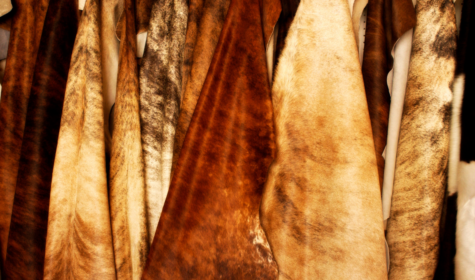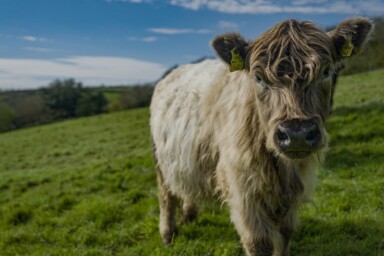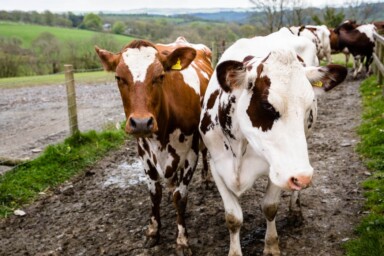We talk about the value of sustainably-sourced local meat a lot, but what about the value of by-products? Abattoirs once received £45 per hide and £6.50 per lamb skin but are now paying significant money to have by-products taken away. Megan Perry, our Head of Policy & Campaigns, explains how the value of hides continues to decrease while the costs of processing have increased, and what can be done to resurrect this dwindling sector.
While the importance of smaller abattoirs has begun to be recognised for their essential role in producing local meat, food security and high animal welfare, what happens to the by-products in such a system is little talked about. Rendering, tanning and incinerating are not generally hot topics of conversation! Yet the world of animal by-products (ABP) has a direct bearing on the local meat supply chain.
The Sustainable Food Trust recently put together a paper for the Defra Small Abattoir Task and Finish Group, co-chaired by the Abattoir Sector Group of which the SFT is a founding member. This paper outlined the stark reality of smaller abattoirs and how costs associated with ABP are impacting their viability. Animal by-products are the materials from animals that are not intended for human consumption and include products such as bones, skin, hooves, horns and blood, as well as whole carcases of animals that cannot be processed for humans. Products are categorised according to risk, and this determines what they can be used for. Some uses include rendering to form protein for animal feed, or anaerobic digestion to produce biogas.
Traditionally, the fifth quarter was a valuable source of income to the abattoir, often providing the ‘operating’ profit for the business. Abattoirs once received £45 per hide and £6.50 per lamb skin, which was enough to cover the slaughter cost. This has now turned on its head and abattoirs pay significant amounts to have ABP taken away, including hides and skins.
Most smaller abattoirs have their ABP collected and processed by rendering companies. Unlike larger abattoirs which have economies of scale, the amount of ABP from a smaller abattoir is relatively small and the abattoir is often located in a rural or remote area, and with the significant decline of other smaller abattoirs there is little chance of collectors visiting multiple operators in one go. This results in collectors and renderers levying high charges and leads smaller abattoirs to ‘bulk up’ their ABP into one container, meaning they are reluctant or unable to begin separating out the ABP for further processing themselves. The consolidation of the ABP processing industry has left small abattoirs with little or no choice as to which companies they use and therefore they must accept whatever the collector charges. This can amount to thousands of pounds per month and is often flagged as one of the mounting costs contributing to small abattoir closures.
Global markets and events have a major impact on the value of ABP. For example, prior to the war in Ukraine, Russia was one of the biggest importers of UK sheepskins. There are also major export challenges due to Brexit, where labelled hides were once sent to Europe on a trailer, there is now 40 pages of documentation to be completed.
Stringent regulation following the BSE outbreak led to the decline of many traditional uses of by-products. The categorisation of ABP and separate infrastructures for processing by category contributed to consolidation of the processing sector. We have been campaigning for the UK Government to apply to the World Organisation for Animal Health for negligible BSE risk status (rather than our current controlled risk status) and we are grateful that this is now being taken forward.
“The consolidation of the ABP processing industry has left small abattoirs with little or no choice as to which companies they use and therefore they must accept whatever the collector charges. This can amount to thousands of pounds per month and is often flagged as one of the mounting costs contributing to small abattoir closures.”
Potential new due diligence regulation, the Forest Risk Commodity Regulation (FRCR), could also have an impact in future as it will prohibit larger companies with a global turnover of more than £50m from using agricultural commodities that have not been produced in line with local laws. Companies will have to provide traceability and evidence that commodities have not been produced on deforested land. This will apply to both beef and leather products.
Reviving local and sustainable leather
While ABP processing represents an entire sector in itself, the production of leather is worth a special focus. The current situation has been described as ‘dire’ by those working in the hide sector. It is believed there were around 4,000 tanneries in the UK in the early 1900s but the sector collapsed in the 1980s with the rise of China and India providing cheap manufacturing and supply chains, coupled with rising costs of more stringent effluent regulations in the UK. By 1983 there were 125 tanneries and by 2015 there were 23. Today, just a small handful of remaining facilities have the capability to process raw hides and skins from the start, and a small number of additional facilities work with material that is already part-processed.
The value of hides has collapsed even further in recent months while the costs of processing (including salt, energy and transport) have gone up. Hides are a global commodity and UK hides currently must compete on a global market. There is a glut in hides globally due to the rise in plastic and other synthetic materials and perhaps also due to an overproduction of cattle, globally, through industrial farming systems. Over half of British hides and nearly all sheepskins are exported or thrown away. Even large abattoirs are paying to have hides taken away as waste, while small abattoirs are spending thousands of pounds purchasing hide shredders so they can be put into landfill.
There is also a huge disconnect between the demands on the fashion industry for sustainability and traceability, and how these are reflected in the leather supply chain. For most leather producers or users, it is not currently possible to trace leather back to the farm of origin or to know how the animal has been reared, and yet the desire for that information is growing.
British Pasture Leather have been working to address this issue since 2021, taking hides from certified Pasture for Life farms to create a supply of traceable and sustainable leather, marketed to designers and brands of leather goods. They also recently launched their ‘Service for Farmers’, offering to get hides vegetable tanned (which involves using natural vegetable tannins to alter the protein structure of the hide, rather than chrome tanning which is seen as environmentally damaging) and returned to those same farms as supple, fully grain quality leather, suitable for producing a range of products from upholstery to footwear. Adding value in this way could be an important part of livestock farm viability in future.
However, what is missing is the capacity to produce this leather in the UK at a volume and cost that would result in a commercially viable price.
“Over half of British hides and nearly all sheepskins are exported or thrown away. Even large abattoirs are paying to have hides taken away as waste, while small abattoirs are spending thousands of pounds purchasing hide shredders so they can be put into landfill.”
One of the main challenges British Pasture Leather is facing, is the bottleneck caused by diminished tanning capacity – the business relies on one tannery in the UK that can process their hides. The capacity of that facility is limited, which also makes the production cost high.
Improving local infrastructure is therefore essential to scaling up the sector. Alongside British Pasture Leather, a small vanguard of people are now at the leading edge of the revival of small-scale leather production, including Billy Tannery, who process goat and deer skins, and Cotmarsh Tannery which has been awarded funding to establish a micro tannery and teaching facility. But further identifying where there is missing infrastructure, particularly for the collection and storage of hides along with tanning capacity, is urgently needed. And British Pasture Leather feels that collaboration to use local hides in local leather production needs to be established to successfully realise this vision.
Alongside this, the founders of British Pasture Leather say that a mentality change is needed and that a vision for leather has to be married to agriculture and viewed from farm to finished material. The origin and production of leather must be better understood and appreciated. Good quality, sustainably sourced and traceable leather with a story, can advance a message about how we want to farm. Leather is emblematic of the agricultural system and landscape from which it came.
With major challenges facing both smaller abattoirs and livestock farmers, anything we can do to add value, improve viability and create a sustainable, local product will be welcomed. Defra have been willing to explore this issue and help identify solutions and we look forward to discussing this further through the Abattoir Sector Group in the coming months.







